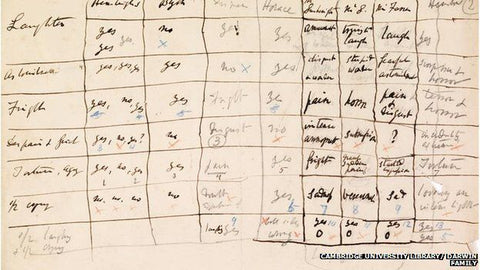Charles Darwin is best known for his theory of evolution by natural selection. His radical ideas and exotic trips are well known worldwide. But what many people aren’t aware of, are his early experiments in the space of human psychology.
Some of his research was rediscovered by Peter Snyder, a neuroscientist at Brown University. Snyder used never before published biographical documents to pull together a full picture of his practices and discoveries before publishing them in the Journal of the History of the Neurosciences in 2010.
"Darwin applied an experimental method that at the time was pretty rare in Victorian England," Snyder said. "He pushed boundaries in all sorts of biological sciences, but what isn't as well known are his contributions to psychology."
In 1872, Darwin asked friends of his to comment on the work of French physician Guillaume-Benjamin-Amand Duchenne. Duchenne believed that human faces expressed at least 60 discrete emotions, each of which depended on its own dedicated group of facial muscles. To recreate these emotions, Duchenne applied electrical current to the faces of test subjects and then created photographics plates of their reactions. Each photograph, he proposed, demonstrated distinct emotions.
Source: Cambridge University Library
Darwin disagreed. He showed a selection of these photographics plates to his friends over dinner and, without leading the conversation, asked what emotions they saw.
Snyder comments that the single blind experiment and randomized presentation of the plates was exceptionally progressive for experimental psychological research at the time.
Darwin's guests agreed almost unanimously about certain emotions - like happiness, sadness, fear, and surprise - but strongly disagreed about what some of the more ambiguous slides showed. Their responses were scribbled down on scrap paper.

Source: Cambridge University Library/Darwin Family
After the experiment at home in Kent, Darwin distributed a questionnaire around the world. And although he couldn't send the pictures themselves, he asked about facial expressions and gestures such as blushing and shrugging among different cultures.
His connections ensured that he received replies from travelers and missionaries as far as South Africa, India, China, North America, and Australia.
Darwin aimed to prove that there is a series of "cardinal" emotions that are expressed and perceived by all humans in the same way, and that these are innate or biological.
The study formed part of his 1872 book The Expression of the Emotions in Man and Animals in which he outlined his view that expression was a trait that humans shared with beasts.
Interestingly he also touched on the concept we now call psychophysiology - the study of the way in which your mind and body affect one-another writing: “The free expression by outward signs of an emotion intensifies it. On the other hand, the repression, as far as this is possible, of all outward signs softens our emotions.”
Sources: BBC and Scientific American
